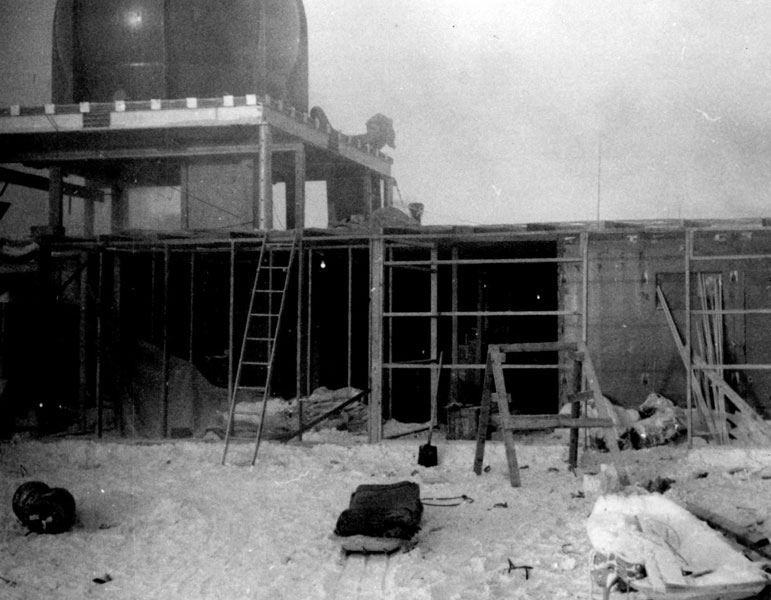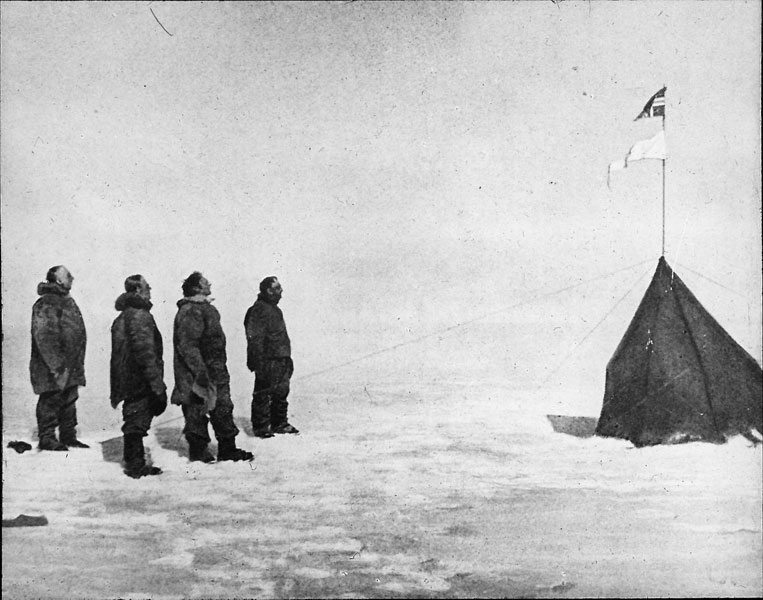First to the Pole
A five-man Norwegian party led by Roald Amundsen was the first to reach the geographic South Pole on 14 December 1911. The experienced team travelled on skis using dog teams to pull sledges. They departed from the Bay of Whales at the edge of the Ross Ice Shelf, a part of the Antarctic coast nearest to the Pole, and pioneered a new route to the Polar Plateau via the Axel Heiberg Glacier. Amundsen had kept his plans to go to the South Pole secret until his ship the Fram was in Madeira and sent his British rival Robert Scott, who was attempting to get to the South Pole first, the following telegram "Beg leave to inform you Fram proceeding Antarctic. Amundsen". Amundsen had attempted to get to the North Pole first but had failed and believed the techniques used in the Arctic could be replicated in Antarctica.
 Robert Scott and four men from his Terra Nova Expedition successfully reached the pole one month later, on 17 January 1912, only to find Amundsen had already planted the Norwegian flag at the South Pole. Tragically, Scott’s party all perished on their return journey as a result of injury, exhaustion, extreme cold and lack of food.
Robert Scott and four men from his Terra Nova Expedition successfully reached the pole one month later, on 17 January 1912, only to find Amundsen had already planted the Norwegian flag at the South Pole. Tragically, Scott’s party all perished on their return journey as a result of injury, exhaustion, extreme cold and lack of food.
Two years earlier on 9 January 1909 Sir Ernest Shackleton, a British national leading a privately funded Antarctic expedition, was the first to reach within one hundred miles of the geographical South Pole. His expedition was also the first to claim to reach the magnetic South Pole, also in January 1909. In 1914, Shackleton led the Imperial Trans-Antarctic Expedition in an attempt to cross the Antarctic continent via the South Pole. However, Shackleton’s ship, the Endurance, became trapped and was crushed in pack ice within the Weddell Sea, forcing the men to abandon the attempt on the crossing. After an epic journey from the Weddell Sea to Elephant Island, Shackleton and some of his expedition then rowed one of their life-boats to South Georgia, where they raised the alarm at a Norwegian whaling station. The remainder of his men were finally rescued from Elephant Island in 1917.
First flights and establishment of South Pole Station
On 29 November, 1929, the South Pole was flown over for the first time in a plane piloted by the Americans Richard Byrd and Bernt Balchen, following a ten-hour flight from the Bay of Whales. The first plane to land at the South Pole, named Que Sera Sera, did so 27 years later in support of the US International Geophysical Year (IGY) expedition in 1956-57. One of its passengers, US Rear Admiral George Dufek, became the first person to stand at the Pole since Scott's party in 1912. During 1956-57 aircraft were used to deliver the materials for construction of the first permanent station at the South Pole, established by the United States. This was officially commissioned as the "Amundsen-Scott IGY South Pole Station" on 23 January 1957.
First Antarctic crossing
There have followed numerous expeditions. The first overland crossing of Antarctica was accomplished by the Commonwealth Trans-Antarctic Expedition led by Sir Vivian Fuchs who, travelling in Sno-Cats from the Weddell Sea region, reached the Pole on January 19, 1958. Sir Edmund Hillary from New Zealand led the Ross Sea support team who laid depots on that side of the continent to re-supply the Fuchs party as they completed the crossing. A lasting legacy of the expedition is the Trans-Antarctic Association, a UK charity established from expedition profits which exists to support scientific research or expeditions of discovery in the Antarctic.
South Pole Station milestones
In the Antarctic summer of 1970-1971, the central area of the original station was dismantled and construction began to build a geodesic dome approximately 50 meters in width, housing instruments for atmospheric monitoring, astronomy and astrophysics projects. This new station was completed on 9th January 1975. It was originally designed to house 18 science and support personnel during each winter and 33 for the duration of the Antarctic summer. However, after the austral summer of 1981-1982, additional personal were accommodated in a group of Jamesways known as 'Summer Camp'. A number of science and berthing structures were added in the 1990s, particularly to assist astronomical and astrophysical research. Then, in 1999, construction of the third South Pole station began. The main station building was elevated and built to mimic the design of an aircraft wing to help prevent the facility being buried by snow, a serious problem in previous years. This facility was dedicated on 12 January, 2008, at the mid-point of the mid-point of International Polar Year 2007-08. Research facilities are located outside of the main station area to minimize interference to science operations.
Some Antarctic expedition milestones
More recently expeditions are finding different challenges and breaking new boundaries. For example in 1980 Sir Ranulph Fiennes and Charles Burton of the British Trans-Globe Expedition became the first to circumnavigate the globe via both geographical poles. In 1989 Arved Fuchs and Reinhold Messner reached the pole overland using only wind assistance and skis. In 2009 Canadians Ray Zahab, Kevin Vallely and Richard Weber completed the overland journey without assistance in a record time of 33 days.
Historic Sites and Monuments
Two sites at the South Pole are designated as Historic Sites and Monuments (HSMs) under the Antarctic Treaty. HSM No.1 commemorates the first Argentine Overland Polar Expedition in 1965. HSM No.80 Amundsen’s Tent was designated in 2005 to give official recognition to the tent which Amundsen left at the Pole in 1911, although this is now deeply buried in ice and has moved some distance from the Pole to a location that is not precisely known.
A marker surrounded by the flags of the original twelve signatory nations of the Antarctic Treaty, known as the Ceremonial South Pole, has been erected by the United States ~150 m grid north of South Pole Station and lies ~200 m from the geographic South Pole. The Ceremonial South Pole commemorates the 1957/58 IGY as well as all expeditions that have reached the South Pole.
 Antarctic Treaty State Flags at the South Pole © Charles Kaminski, 2005, NSF, USAP Photo Library
Antarctic Treaty State Flags at the South Pole © Charles Kaminski, 2005, NSF, USAP Photo Library 


